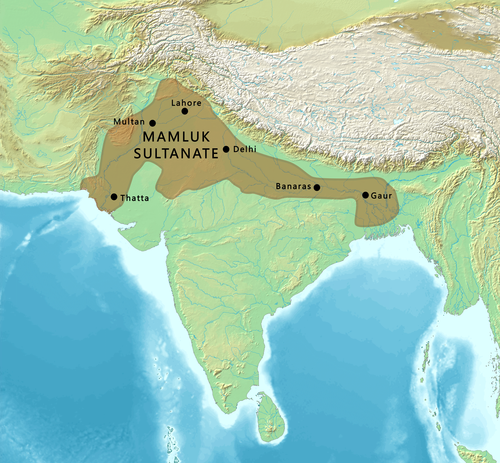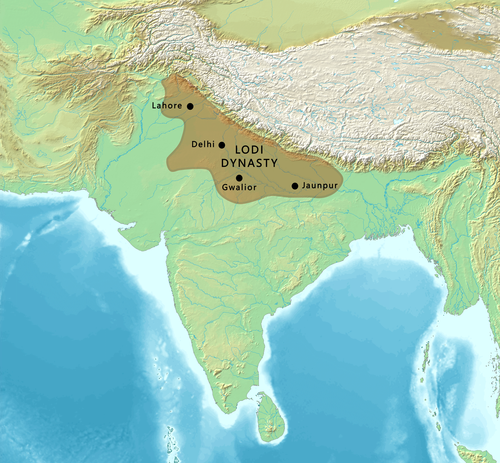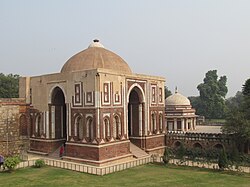Delhi Sultanate
The Delhi Sultanate (دلی سلطنت), or Sultanate-e-Hind (سلطنتِ ہند or Empire of India) or Sultanate-e-Dilli (سلطنتِ دلی or Empire of Delhi) were the Sunni Islamic Persian/Hindavi speaking dynasties of Turkic, Punjabi[14][15] and Pashtun origin,[16] which were controlling most of the Indian subcontinent from 1210 to 1526. Most of these dynasties ruled from Delhi. This includes the Slave dynasty (1206-90), the Khilji dynasty (1290-1320), the Tughlaq dynasty (1320-1413), the Sayyid dynasty (1414-51), and the Lodi dynasty (1451-1526). The reign of the Delhi Sultans ended after Ibrahim Lodi of the Lodi Dynasty was defeated by Babur and killed in action in the Battle of Panipat.[17]
Sultanate of Delhi | |||||||||||||||||||||||||
|---|---|---|---|---|---|---|---|---|---|---|---|---|---|---|---|---|---|---|---|---|---|---|---|---|---|
| 1206–1526 | |||||||||||||||||||||||||
| Status | Sultanate | ||||||||||||||||||||||||
| Capital | |||||||||||||||||||||||||
| Official languages | |||||||||||||||||||||||||
| Religion | State religion Sunni Islam Others Hinduism (majority), Jainism, Buddhism, Christianity, Zoroastrianism | ||||||||||||||||||||||||
| Government | Monarchy | ||||||||||||||||||||||||
| Sultan | |||||||||||||||||||||||||
• 1206–1210 | Qutb ud-Din Aibak (first) | ||||||||||||||||||||||||
• 1517–1526 | Ibrahim Lodi (last) | ||||||||||||||||||||||||
| Legislature | Corps of Forty (1211–1266) | ||||||||||||||||||||||||
| Historical era | Medieval India | ||||||||||||||||||||||||
• | 25 June 1206 | ||||||||||||||||||||||||
• | 21 April 1526 | ||||||||||||||||||||||||
| Area | |||||||||||||||||||||||||
• 1312 | 3,200,000 km2 (1,200,000 sq mi)[8] | ||||||||||||||||||||||||
| Population | |||||||||||||||||||||||||
• 1500 estimate | 101,000,000[9] | ||||||||||||||||||||||||
| Currency | Taka | ||||||||||||||||||||||||
| |||||||||||||||||||||||||
| Today part of | |||||||||||||||||||||||||
Sultans of Delhi
Mamluk, or Slave dynasty (1206 - 1290)
- Qutb-ud-din Aibak (1206 - 1210)
- Aram Shah (1210 - 1211)
- Shams-ud-din Iltutmish (1211 - 1236)
- Rukn ud din Firuz (1236)
- Raziyyat ud din Sultana (1236 - 1240) (Raziyya Sultana)
- Muiz ud din Bahram (1240 - 1242)
- Ala ud din Masud (1242 - 1246)
- Nasir ud din Mahmud (1246 - 1266)
- Ghiyas ud din Balban (1266 - 1286)
- Muiz ud din Qaiqabad (1286 - 1290)
- Shamsuddin Kayumars (1290)
Khilji (Khalji) dynasty (1290 - 1320)
- Jalal ud din Firuz Khilji (1290 - 1294)
- Ala ud din Khilji (1294 - 1316)
- Qutb ud din Mubarak Shah (1316 - 1320)
Tughlaq dynasty (1321 - 1398)
- Ghiyas ud din Tughluq Shah I (1321 - 1325)
- Muhammad Shah II (1325 - 1351)
- Mahmud Ibn Muhammad ( March 1351)
- Firuz Shah Tughluq (1351 - 1388)
- Ghiyas ud din Tughluq II (1388 - 1389)
- Abu Bakar (1389 - 1390)
- Nasir ud din Muhammad Shah III (1390 - 1393)
- Sikander Shah I ( March - April 1393)
- Mahmud Nasir ud din (Sultan Mahmud II) at Delhi (1393 - 1394)
- Nusrat Shah at Firuzabad (1394 - 1398)
Sayyid (Syed) dynasty (1414 - 1451)
- Khizr Khan (1414 - 1421)
- Mubarrak Shah II (1421 - 1435)
- Muhammad Shah IV (1435 - 1445)
- Aladdin Alam Shah (1445 - 1451)
Lodi (Lodhi) dynasty (1451 - 1526)
- Bahlol Khan Lodi (1451-1489)
- Sikandar Lodi (1489-1518)
- Ibrahim II (1517-1526)
1526-1540: Mughal rule after the First Battle of Panipat
Delhi Sultanate Media
Tomb of Iltutmish (r. 1211–1236) in the Qutb Minar complex.
Territory controlled by Khalji dynasty circa 1320.[18]
The Alai Darwaza, completed in 1311 during the Khalji dynasty.
Related pages
References
- ↑ 1.0 1.1 Schwartzberg, Joseph E. (1978). A Historical atlas of South Asia. Chicago: University of Chicago Press. p. 147. ISBN 0226742210.
- ↑ Schwartzberg, Joseph E. (1978). A Historical atlas of South Asia. Chicago: University of Chicago Press. p. 38. ISBN 0226742210.
- ↑ Jackson 2003.
- ↑ 4.0 4.1 Schwartzberg, Joseph E. (1978). A Historical atlas of South Asia. Chicago: University of Chicago Press. p. 148. ISBN 0226742210.
- ↑ Eaton, Richard Maxwell (2015). The Sufis of Bijapur, 1300–1700: Social Roles of Sufis in Medieval India. Princeton University Press. pp. 41–42. ISBN 978-1-4008-6815-5.
- ↑ Alam, Muzaffar (1998). "The pursuit of Persian: Language in Mughal Politics". Modern Asian Studies. Cambridge University Press. 32 (2): 317–349. doi:10.1017/s0026749x98002947. S2CID 146630389.
Hindavi was recognized as a semi-official language by the Sor Sultans (1540–1555) and their chancellery rescripts bore transcriptions in the Devanagari script of the Persian contents. The practice is said to have been introduced by the Lodis (1451–1526).
- ↑ "Arabic and Persian Epigraphical Studies - Archaeological Survey of India". Asi.nic.in. Archived from the original on 29 September 2011. Retrieved 29 January 2018.
- ↑ Turchin, Peter; Adams, Jonathan M.; Hall, Thomas D. (December 2006). "East-West Orientation of Historical Empires Archived 17 May 2016 at the Portuguese Web Archive" (PDF). Journal of World-Systems Research. 12 (2): 222–223. ISSN 1076-156X. Archived (PDF) from the original on 7 July 2020. Retrieved 7 July 2020.
- ↑ Maddison (27 July 2016). "Growth of World Population, GDP and GDP Per Capita before 1820" (PDF). Archived from the original (PDF) on 12 February 2021. Retrieved 9 May 2023.
- ↑ Jackson 2003, p. 28.
- ↑ Grey flag with black vertical stripe according to the Catalan Atlas (c. 1375):
 in the depiction of the Delhi Sultanate in the Catalan Atlas
in the depiction of the Delhi Sultanate in the Catalan Atlas
- ↑ Kadoi, Yuka (2010). "On the Timurid flag". Beiträge zur islamischen Kunst und Archäologie. 2: 148. doi:10.29091/9783954909537/009. S2CID 263250872.
...helps identify another curious flag found in northern India – a brown or originally silver flag with a vertical black line – as the flag of the Delhi Sultanate (602–962/1206–1555).
{{cite journal}}: Check|s2cid=value (help) - ↑ Note: other sources describe the use of two flags: the black Abbasid flag, and the red Ghurid flag, as well as various banners with figures of the new moon, a dragon or a lion.Qurashi, Ishtiyaq Hussian (1942). The Administration of the Sultanate of Delhi. Kashmiri Bazar Lahore: SH. MUHAMMAD ASHRAF. p. 143.
Large banners were carried with the army. In the beginning, the sultans had only two colours : on the right were black flags, of Abbasid colour; and on the left, they carried their colour, red, which was derived from Ghor. Qutb-ud-din Aibak's standards bore the figures of the new moon, a dragon or a lion; Firuz Shah's flags also displayed a dragon.
Jha, Sadan (8 January 2016). Reverence, Resistance and Politics of Seeing the Indian National Flag. Cambridge University Press. p. 36. ISBN 978-1-107-11887-4., also "On the right of the Sultan was carried the black standard of the Abbasids and on the left the red standard of Ghor." in Thapliyal, Uma Prasad (1938). The Dhvaja, Standards and Flags of India: A Study. B.R. Publishing Corporation. p. 94. ISBN 978-81-7018-092-0. - ↑ Easton, Richard M. (2019). India in the Persianate Age: 1000–1765. University of California Press. p. 105. ISBN 978-0520325128.
The career of Khizr Khan, a Punjabi chieftain belonging to the Khokar clan, illustrates the transition to an increasingly polycentric north India.
- ↑ Orsini, Francesca; Sheikh, Samira (2014). After Timur Left: Culture and Circulation in Fifteenth-century North India. Oxford University Press. ISBN 978-0-19-945066-4.
- ↑ Ramananda Chatterjee (1961). The Modern Review. Vol. 109. Indiana University. p. 84.
- ↑ Chandra, Satish (2005). Medieval India: From Sultanat to the Mughals Part – II. Har-Anand Publications. pp. 30–31. ISBN 978-81-241-1066-9.
- ↑ Schwartzberg 1978, p. 147, map XIV.3 (i).
Literature
- Elliot and Dowson: The History of India as told by its own Historians, (New Delhi) reprint, 1990.
- Peter Jackson The Delhi Sultanate. A Political and Military History (Cambridge) 1999
- Majumdar, R. C. (ed.), The History and Culture of the Indian People, Volume VI, The Delhi Sultanate, (Bombay) 1960; Volume VII, The Mughal Empire, (Bombay) 1973.
- Nizami, Khaliq Ahmad Some Aspects of Religion and Politics in India in the Thirteenth Century (Delhi) 1961 (Revised Edition Delhi 2002)
Other websites
- Delhi Sultanate Dynasty Archived 2020-06-06 at the Wayback Machine
- List of rulers of Delhi Archived 2007-06-29 at the Wayback Machine








